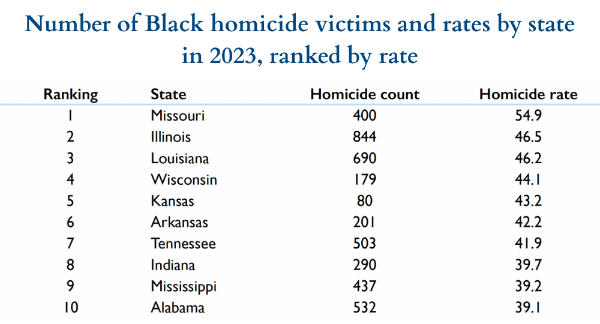Wisconsin Has 4th Highest Black Homicide Victimization Rate in the Nation
Washington, D.C. — Nearly nine out of 10 of Black homicide victims die by gunfire according to the latest edition of Black Homicide Victimization in the United States: An Analysis of 2023 Homicide Data, an annual study from the Violence Policy Center(VPC). In 2023 (the most recent year for which data are available), there were 12,276 Black homicide victims in the United States. Of these victims, 10,563 (86.0 percent) died by gunfire. Black Americans comprised 13.7 percent of the U.S. population that year yet represented 53.8 percent of all homicide victims.
Nationwide, the Black homicide victimization rate was 26.6 per 100,000. Wisconsin’s Black homicide victimization rate of 44.1 per 100,000 was the fourth highest in the nation. In 2023, the 10 states with the highest Black homicide victimization rates were: Missouri, Illinois, Louisiana, Wisconsin, Kansas, Arkansas, Tennessee, Indiana, Mississippi, and Alabama (see table below).
Nick Matuszewski, associate executive director at WAVE Educational Fund, states, “Wisconsin again ranks near the top for Black homicide victimization, with most deaths caused by guns. This is a public safety crisis deeply rooted in racial inequity and systemic neglect. We urgently need universal background checks, extreme risk laws, and sustained investment in community violence intervention programs. These proven policies save lives and support Black communities facing this ongoing trauma. Meanwhile, the gun lobby continues to push policies that put more guns in Black communities, fueling harm instead of healing. It is past time for our elected officials to step up, act decisively, and protect all Wisconsinites.”
For WISCONSIN, the study found that:
- There were 179 Black homicide victims in 2023.
- The homicide rate among Black victims was 44.1 per 100,000 in 2023.
- Twenty-three homicide victims were less than 18 years old (12.8 percent). Fewer than 10 victims were age 65 or older.
- Out of 179 homicide victims, 148 (82.7 percent) were male and 31 (17.3 percent) were female.
- Most victims were killed by firearms (88.3 percent or 158 out of 179).
- For homicides in which the victim to offender relationship could be identified, 84.6 percent of victims (55 out of 65) were killed by someone they knew. Ten victims were killed by strangers.
- For homicides in which the circumstances could be identified, 78.0 percent (64 out of 82) were not related to the commission of any other felony. Of these, 59.4 percent (38 homicides) involved arguments between the victim and offender.
Additional information for the UNITED STATES contained in the study includes:
- Of the 12,276 Black homicide victims, 10,464 (85.2 percent) were male and 1,812 (14.8 percent) were female. Guns were used against 88.1 percent of all male Black homicide victims and 74.0 percent of all Black female homicide victims.
- The Black homicide victimization rate (26.6 per 100,000) wasnearly four times the overall national homicide victimization rate (7.1 per 100,000) and nearly seven times the white homicide victimization rate (3.9 per 100,000).
- The Black male homicide victimization rate (46.1 per 100,000) was more than four times the overall male victimization rate (11.3 per 100,000) and more than eight times the white male homicide victimization rate (5.7 per 100,000).
- The Black female homicide victimization rate (7.8 per 100,000) was nearly three times the overall female victimization rate (2.8 per 100,000) and more than four times the white female homicide victimization rate (1.9 per 100,000).
At the same time that guns are devastating the Black community, the firearms industry is working to expand beyond its saturated market of white male gun owners, focusing its marketing efforts on Black, Latino, and Asian Americans. If successful, such efforts can only increase gun death and injury in these communities (see the 2021 Violence Policy Center studies How the Firearms Industry and NRA Market Guns to Communities of Color and How the Firearms Industry Markets Guns to Asian Americans).
The full study is available in PDF format at https://vpc.org/studies/blackhomicide25.pdf.
Past editions of the study are available at https://vpc.org/revealing-the-impacts-of-gun-violence/black-homicide-victimization/.
NOTE: This press release was submitted to Urban Milwaukee and was not written by an Urban Milwaukee writer. While it is believed to be reliable, Urban Milwaukee does not guarantee its accuracy or completeness.
Mentioned in This Press Release
Recent Press Releases by WAVE Educational Fund
New VPC Study Reveals “Hidden” Gun Manufacturers Across Wisconsin
Nov 18th, 2025 by WAVE Educational FundFederal Gun Manufacturing Licenses Can be Used to Evade Gun Laws, Buy Guns in Quantity at Wholesale Prices, and Undercut Restrictions on the Possession of New Fully Automatic Machine Guns
Annual Study – Gun Death in Wisconsin – Released by Wisconsin Anti-Violence Effort (WAVE) Educational Fund and Violence Policy Center
Oct 14th, 2025 by WAVE Educational FundGuns Claimed 762 Lives in Wisconsin in Suicides, Homicides, and Other Firearm Deaths According to Latest Data























